It may have all come from the proverb that cats have nine lives, but that's how many people think – that each year of an animal is equal to nine human years. However, according to experts, our pets actually age much faster.
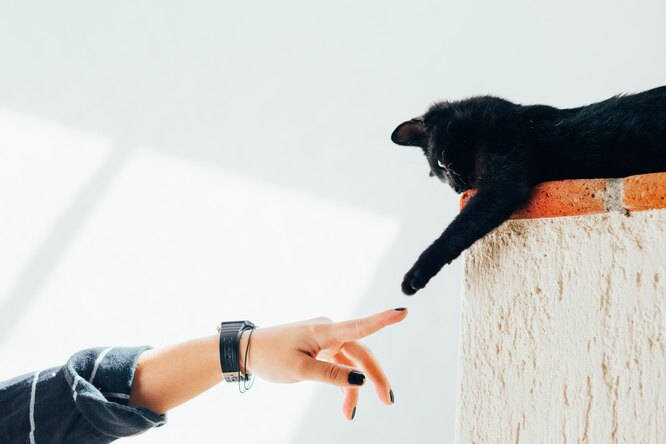
- The age of the cat according to human standards
- Kittens from birth to six months
- Kittens from 6 months to 3 years
- How do you calculate a cat's age in human years?
- How can you be more precise?
- Stages of life
- How to determine the exact age
- Eyes
- Hair
- How old is the cat by human standards? Let's try to measure.
- How to really count
- How do you translate a cat's age into human age?
- How old is my pet by human standards?
- How old do cats live and how to calculate their age
- What does the longevity of cats depend on
- Factors affecting a cat's health and how to increase the longevity of cats
- Breeds of long-lived cats
The age of the cat according to human standards
It happens that a seemingly mature and large-sized pet behaves like an unexperienced kitten, that just recently started crawling out of the nest and actively learning the world. Maybe he's still a baby (a teenager). I wonder how old he is by human standards.
There can be no serious scientific research on this topic – the growth and development of each species of living beings is unique. However, we do not aim to establish how correct it is to compare the age of a cat and a human, and we are not going to prove that all comparative tables will be to some extent tentative.
After all, cats also have certain periods of life: childhood, adolescence, maturity, and (if you're lucky) old age. I must say that the timing of maturation in cats (especially purebreds) varies greatly. There are breeds that reach full growth and development by 3-4 years of age.
In general, the age of a cat in terms of human years looks like this.
At three months of age, a kitten can separate from its mother without harm to its physical and mental health.
Kittens from birth to six months
The first six months of a kitten's life are devoted to learning about the world. At 1-2 weeks of age, the baby has sight and hearing and begins active physical and mental development. The kitten is exposed to images, sounds and smells just like a human infant. Each new animal, person and object he encounters helps shape his personality.
At 2-3 months of age, most kittens leave their mother and become more independent and curious. At this time, kittens grow very actively and by six months of life can be compared in level of development to a 10-year-old child.
Kittens from 6 months to 3 years
A kitten over the age of six months is already a teenager who is still learning about the world and setting her own boundaries. At one year of age, a young cat generally reaches its adult size and no longer grows (except outwards). Her preferences and habits are also well established. A one-year-old cat is physiologically comparable to a 15-year-old teenager, and a two-year-old cat to a human about 24 years old.
Three to six years of age is the prime of a cat's youth. During these years, as a rule, animals do not have serious health problems, unless we are talking about congenital and hereditary diseases, which should have been detected even earlier. The cat is full of strength and energy. These are the best years of her adult life. A five-year-old animal can be compared to a human barely 30 years old.
How do you calculate a cat's age in human years?
There are many ways, and experts often have very different opinions. There is the simplest and most widely known way to find out the age of a cat: to count each cat year as seven human years. With this method, you can roughly imagine how old you just threw a shoe at the old lady.
This seemingly simple and easy method of calculation, alas, is far from perfect: it is inaccurate and gives only an approximate result. Even humans don't develop evenly throughout life, so what about creatures like cats?
How can you be more precise?
Scientists-felinologists have studied this question for many years, and have managed to create a table, with the help of which you can see the ratio of the stages of development of a cat in relation to human. You can use this calculator to calculate the human age of an animal more accurately.
When looking at the data in the table, it is clear that in thea cat learns about as much for itself in its first year of life as a human cub does in its fifteenth year. It's only the second year, and your cat is sure to be sold alcohol and allowed into the club – after all, you count 24. After the second year, development slows down, there's no rush, it makes sense to enjoy being young and active.
Each new year adds to the internal age of your pet only 4 years. Thus, a sixteen year old cat is already an eighty year old lady.
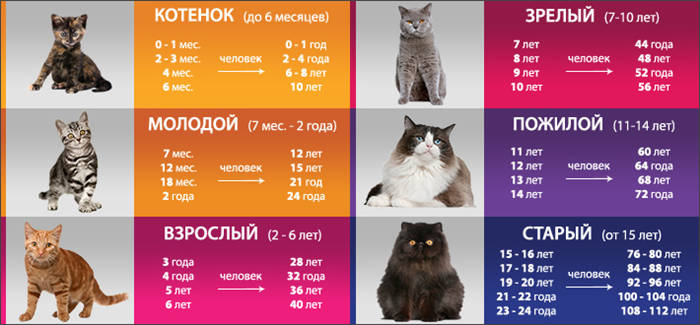
How a cat's age is considered by human standards:
- 1 year old cat is 15 years human;
- 2 year old cat – 24 years old;
- 3 years old – 28 years old;
- 4 years old – 32 years old;
- 5 years old – 36 years old;
- 6 years – 40 years;
- 7 years – 44 years;
- 8 years – 48 years;
- 9 years – 52 years;
- 10 years – 56 years;
- 11 years – 60 years;
- 12 years – 64 years;
- 13 years – 68 years;
- 14 years – 72 years;
- 15 years – 76 years;
- 16 years – 80 years.
Stages of life
- The first stage: childhood. It lasts about six months after birth. During this time, the kitten learns the world around him and its dangers, constantly receiving new information. So far, he walks around with his mother, who teaches him everything and protects him from the dangers. At the end of the first stage of a cat's life, we have an 8-12 year old child.
- The second stage: adolescence. Lasts from six months to two years. Feline puberty, a period of maturation, puberty. By one year the cat is biologically ready to give birth, but it is better to wait up to two years – by this time it acquires all the vital skills and abilities.
- The third stage: youth. The peak of development and activity. It lasts from three to five years. The cat is playful, intelligent, inquisitive and very active. Ready to reproduce healthy offspring. If you compare it to human life, then here we are no longer a teenager, but a young man who has graduated from university and found a good job.
- The Fourth Stage: Maturity. From the seventh to the tenth year of life. A cat becomes cynical and indifferent to the world, and he cares less about it. More time is spent sleeping, and the animal's gaze becomes dismissive and proud. The cat is still healthy and has a lot of energy, but there is not much desire to spend it on silly games anymore.
- Stage five: retirement. Only thanks to today's veterinary advances have cats en masse begun to discover this great stage of their lives. Now they enjoy life as humans do about 60-70 years old. Such animals live exclusively for themselves and for their own pleasure. They sleep, eat, and look at the birds in the windows for a long time, no longer trying to catch them, no longer nervous.
- The sixth stage: old age. Cats at the age of 15-16 years are already considered to be long-livers. If your pet or pets have lived up to this stage, you are lucky. In this period of life, they become affectionate, faithful, require more attention, love, care and warmth
How to determine the exact age
To know exactly how old a cat is, it's best to show it to a veterinarian. But you can determine its age yourself by checking the signs. One of the most reliable indicators is the condition of her teeth.
Teeth won't help you determine the exact date of birth of your four-legged friend, but they are still a great indicator of age. Key milestones in dental development:
- A kitten's first teeth appear two to four weeks after birth.
- Permanent white teeth appear around four months later.
- Yellow spots, also known as tartar, on some teeth may mean that a cat is one to two years old.
- If spots appear on all teeth, the cat is probably three to five years old.
- Lack of teeth is usually a sign of a solid age – 10 to 15 years.
But keep in mind that some cats may have worse teeth than their relatives, regardless of age.
Now you know how many years a cat lives by human standards. But it could be more: give it the right food, lots of good care, and always check up on it at the vet.
You'll find a wide variety of products for your pets in our catalog.
Eyes
Another indicator of age in cats is the eyes. At the age of 6-7 years, the crystals of a cat's eyes become more dense. When examined with an ophthalmoscope, you may find some clouding – similar to what happens in humans at age 40 and older. For cat owners such changes usually remain unnoticed, but after the age of 10 they can already be seen without special instruments.
The iris of a cat's eyes also changes with age. Its inner part can begin to deteriorate (atrophy), making the pupil now look larger. Sometimes the inner edge of the iris seems to become wavy.
Hair
The fur of kittens is usually short and thick, and in young cats the hair feels soft and thin, but with age it becomes thicker and coarser. The cat's color can also change: it can suddenly darken or, conversely, lighten.
Gray in cats is a rare occurrence. If gray hairs do appear, it is in small quantities and mainly on the muzzle.
Observe how the cat takes care of its hair. Young animals tend to lick greedily and for a long time. Older animals, in contrast, are not as meticulous about grooming. This can be due to dental disease, which makes the cat uncomfortable, or to weight gain, when the animal is no longer as flexible and agile. Another possible cause is arthritis, which makes any twisting painful.
How old is the cat by human standards? Let's try to measure.
It is said that a cat has nine lives. However, our pets live much less than humans, who have only one life. Many cat owners wonder how old their cat is by human standards. And what if he is already celebrating his 50th birthday? And is it not time to call the pet respectfully – Barsik Kuzmich?
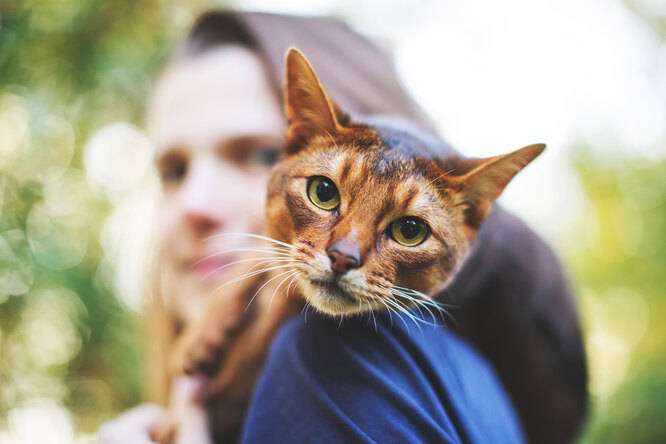
How to "calculate" the age of the cat? Is it older or younger than you by human standards? After all, many things change with age, including physical activity and diet.
How to really count
The "seven-year rule" doesn't actually adequately calculate your pet's age. In the wild, cats had to mature very quickly to have time to give birth and have the strength and ability to care for, feed and protect them. That is why cats "age" much faster in their first years of life than humans do. So, in its first year of life alone, a cat becomes 15 years older, and its age is equivalent to that of a human teenager. We count age to one year: at four months a cat is 5 human years, at 8 months it is 10 years, at 12 months it is 15 years. In the second year, the cat becomes 9 years older. In total, by its two-year birthday a cat reaches the human age of 24.
And further on in the cat's calendar each year already goes for 4 human years. That is, at the age of 3 the cat is 28 years, at 6 years – 40, 8,5 years – 50, and at 21 years – 100. If it survives, pardon the prose of life.
How do you translate a cat's age into human age?
According to popular legend, one human year is equal to seven cat years. In fact, a twelve-month-old cat is much older than a seven-year-old child. How to translate a pet's age, our experts figured out.
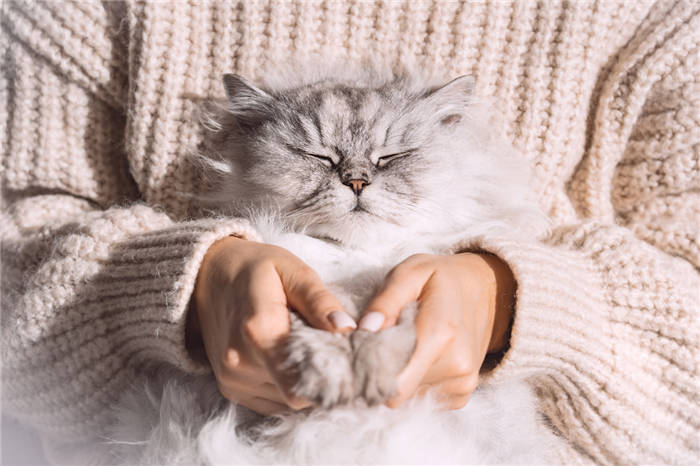
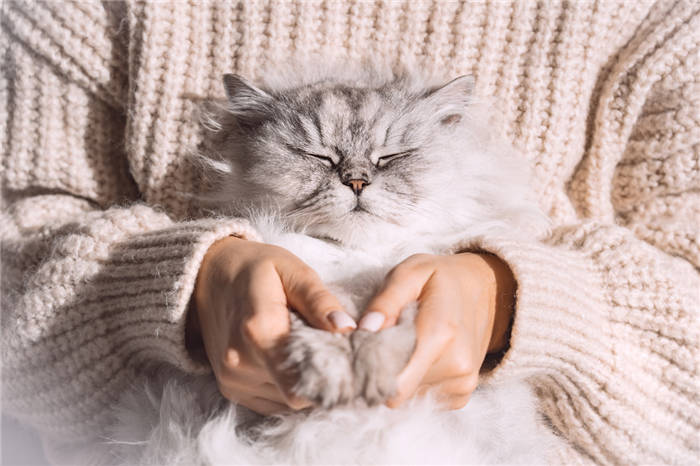
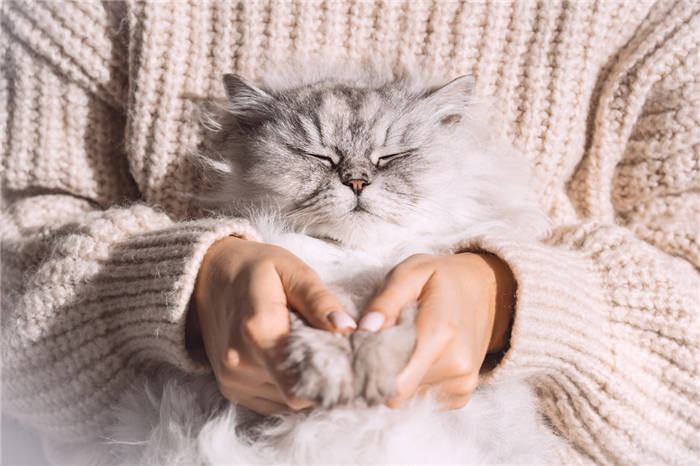
How old is my pet by human standards?
There is no exact scientific way to calculate the ratio between years. It is generally accepted that the first year of a pet's life is equal to 15 human years. The second adds another 9 human years to the total. This means that 2 cat years equals about 24 human years.
Then add 4 cat years to each human year. That is, if your pet is 6 years old, their equivalent feline age in human years would be about 41.
How old do cats live and how to calculate their age
How long do cats live? The average domestic cat lives 12 to 15 years. Homeless and street animals live an average of 3-5 years. There is virtually no gender difference in the life expectancy of cats and cats.
How long do neutered cats live? Neutered cats live 2-3 years longer if they don't have genetic diseases. Spayed cats also live longer.
How long do British cats live? British cats are among the long-living cats. They live on average 15 years, and some pets live more than 20 years. Olesya Pukhova , author of the book "British Shorthair Cats", specifies that the British grow up very slowly. Only at the age of 5 years they reach their full maturity.
How long do sphynx cats live? Sphynx cats have poor health, so they do not live long. Their life expectancy reaches an average of 9-14 years, under favorable conditions – 15-18 years.
Cats, like people, have their own periods of life: childhood, adolescence, formation, reproductive age, old age. The stages of their lives are as follows:
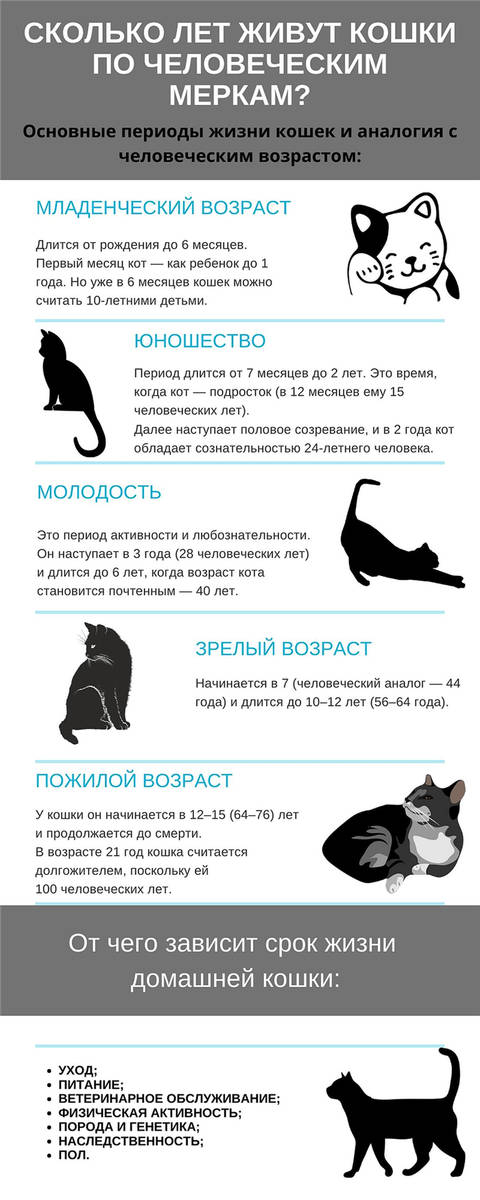
- Kittens are completely dependent on mother's milk for 8-10 weeks. Then they switch to other foods and become independent.
- Puberty occurs in cats at 8-10 months, in cats at 6-8 months.
- Reproductive age in cats lasts throughout their lives. There is an increased risk of death when older cats give birth.
How to count the age of cats? If you compare a cat's age to a human life, one human year equates to seven cat years. Cats age faster in the first years of life, so the "7-year rule" does not reflect the actual picture. As a result, a cat's life by human standards looks like this:
- In 1 year, a cat lives virtually 15 human years and goes from childhood to adolescence.
- During the second year of life, the cat reaches puberty and begins reproducing offspring (puberty and the beginning of reproductive age), which equates to 24 years of human life.
- Starting from the third year of life, cats can add 4 years of human life each year.
- A cat reaches old age at 11-12 years, which equates to 60-64 years of human life.
- If a cat lives more than 12 years, it passes into old age and reaches the advanced human age of 75-90 years. Long-lived cats that have lived more than 20 years can claim their 100th human birthday.
What does the longevity of cats depend on
The longevity of cats depends on many factors. These include the cat's breed, lifestyle (domestic or homeless), health, nutrition, and care.
Pedigreed house cats often live shorter lives than non-breeds. It all depends on immunity and resistance to hereditary and viral diseases. Breeds of long-living cats include Maine Coon, Bengal, Russian Blue, Siamese, Burmese, and ragdoll, who live an average of 20-23 years.
If the cat lived in the house and then ended up on the street, its life is in mortal danger. Such a cat will not be able to survive in extreme conditions, getting food and warmth. The only salvation is to get closer to a human near a house or a cafe.
The life of street cats is subject to other dangers. They are not afraid of hunger and cold, but they can die under the wheels of a car or in other force majeure. Many street animals die without vaccination against viral diseases and invasion of ectoparasites.
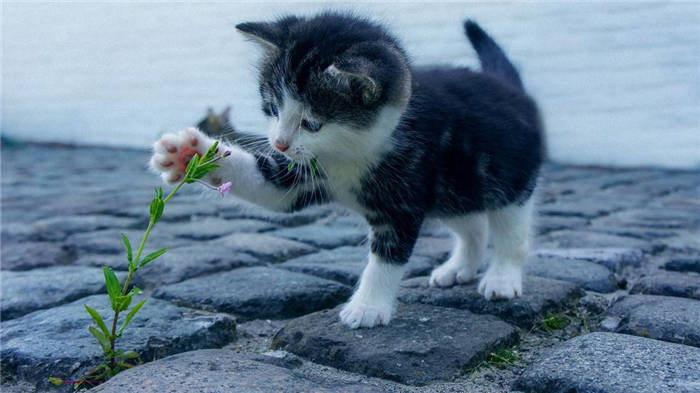
Dreaming of a long-lived domestic cat, create all conditions for a better quality of life of the cat:
- Feeding. Choose a suitable diet with sufficient vitamins, proteins and micronutrients. Do not mix dry and natural food. Feed pets on a schedule, do not overfeed. Give kittens four to six meals a day, adult cats transfer after one year to two meals a day.
- Home environment. Cats are social animals. They love affection, care and become attached to people. The animal should not be left alone for long periods of time, handed over to other people. Stress reduces the cat's immunity and leads to its early death.
- Care. Kittens from childhood are accustomed to order and cleanliness. A pet should have its own place, a scratching post, bowls for food and water, and a litter box, or preferably two, as advised by Rosvita Berger, author of the book "Raising Cats and Understanding Their Behavior. Cats are brushed, bathed occasionally, have their nails shined, and have their ears, eyes and teeth cleaned.
- Health. Cats must have vaccinations and preventive checkups at the vet to make sure they don't miss health problems. Gill Deborah , author of the book "Cats: a mini-encyclopedia", advises in the first place to vaccinate cats against dangerous diseases – enteritis and influenza. The animal is given special funds against worms and ectoparasites. If you do not plan to breed kittens, be sure to spay the cat and neuter the cat.
Factors affecting a cat's health and how to increase the longevity of cats
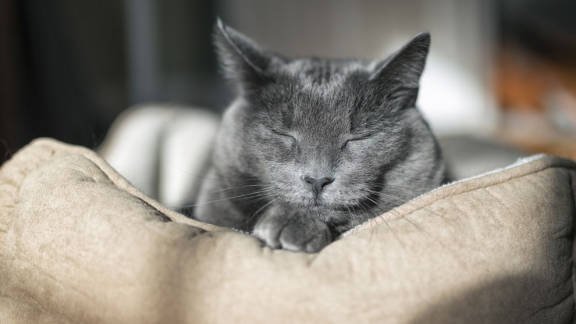
To make the pet feel good and enjoy it as long as possible, owners should pay attention to the moments that affect how long their pet will live:
- Breed. A lot depends on it. It affects immunity, genetic changes, diseases, and activity. The more "pure" and artificially bred breeds, the shorter the life span of their representatives. Native breeds, or those that have evolved with minimal human intervention, are usually stronger and healthier.
- Cat sterilization. Pets often have hormonal malfunctions and various diseases related to the reproductive system. Neutered and neutered pets live 4-5 years longer, but it is very important to monitor their nutrition and activity: such pets are prone to overweight.
- Overweight. As for people, a sedentary lifestyle is harmful for animals, and various activities not only develop muscles, but also strengthen health.
- A visit to the veterinarian. Timely vaccination, observation by a specialist and competent care may well make a long-lived animal, at the same time improving the quality of his life.
- A balanced diet. What to feed his cat – natural food or ready-made food, every owner decides for himself. But in both cases it is important that the food is balanced, regular and of good quality. It should contain all the necessary vitamins, minerals and other trace elements. The Purina ONE® line of cat foods meets all these requirements. Among its foods, you can choose the one that best suits the pet.
- Heredity. No matter how good their care may be, if parents pass on hereditary diseases to their cats, the best thing an owner can do is to identify them as early as possible by taking the cat to the vet, and strictly follow all recommendations of the specialist.
Breeds of long-lived cats
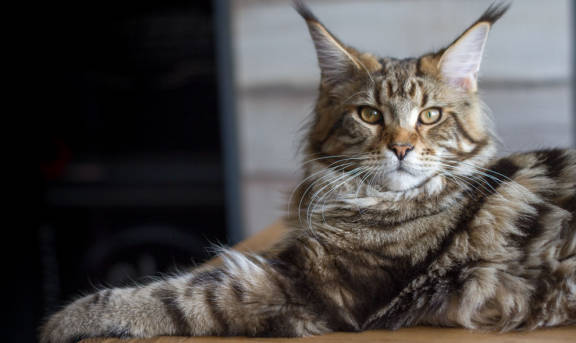
For some people, the longevity of their pet is very important. They want to enjoy the company of their four-legged friend for as long as possible. Such people should pay attention to cat breeds that are known for their longevity. Other things being equal, these cats and cats live much longer than their brethren:
The answer to the question, "How long do cats live?" – is very individual and must be considered on a case-by-case basis. But no matter how long the pet lives, the task of the owners to make his life comfortable, surround his four-legged friend with care and human love.






